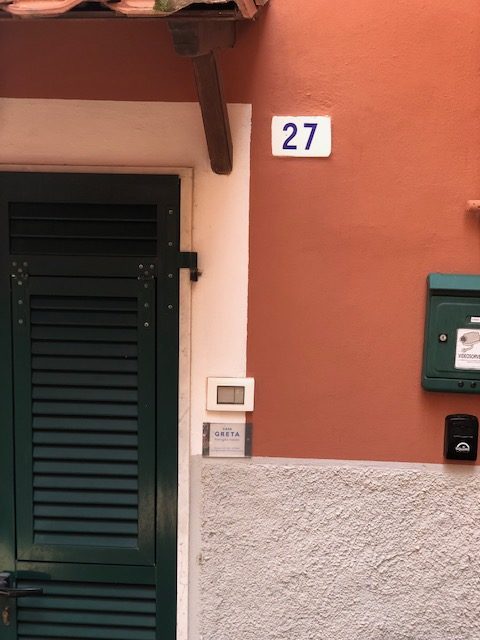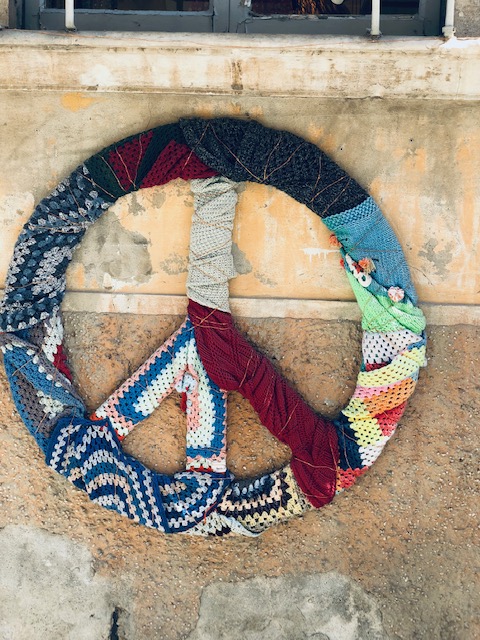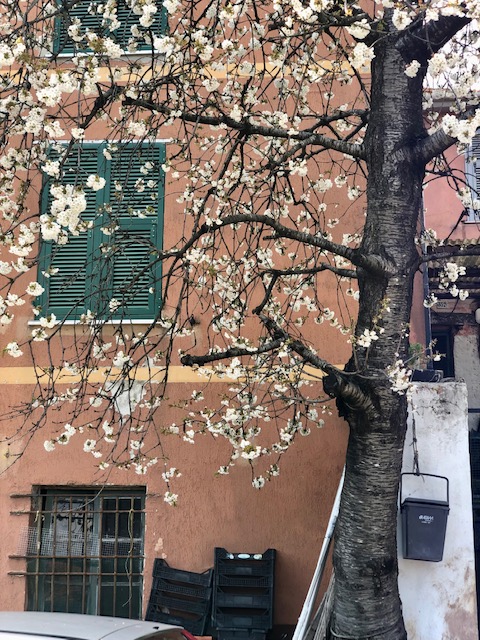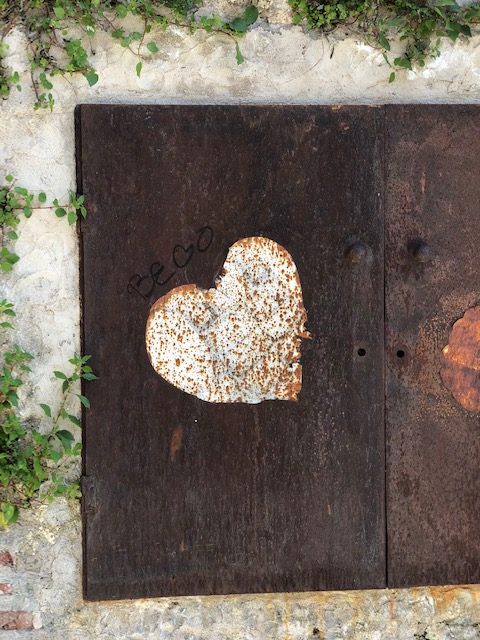

Friday evening my husband, Massi took a stab at making the impressive, Ligurian Easter classic Torta Pasqualina or Easter Tart. He also aced it.
I’ll be honest, it is a time-consuming undertaking. Major cheating is possible by using store bought puff or filo pastry, but the flakiness of the home-made variety is superb.
Also, the prep is complex. A quick glance at the recipe or the tart itself tells you this, and when I heard Massi whistling as he prepared it, I knew this to be true. He’d never admit it, but he whistles to convey the idea that everything is eeeeasssy. To the rest of the household, it’s a flag, that things are starting to slide. Sideways. Or, downhill. I guess ideally, you would prep the elements of this pie in advance, leaving yourself with the just the breezy assembly and cooking as Easter approached.
So, what are the elements? Lots of pastry. Traditionally, torta pasqualina is made from 33 layers of finely stretched pastry, each representing one year of the life of Christ. The tarts fillings – a vegetable layer, made with seasonal herbs and greens (marjoram, chard, spinach, artichokes, or a combo), and a cheesy layer made with the fresh curds cheese prescinseua from Genoa. Eggs and parmigiano are slipped in everywhere to enrich the lot.
What distinguishes torta pasqualina from other tarts – apart from the epic pastry layers – is the rather flashy technique of making small wells in the tart filling into which more eggs are cracked, one egg for each hole (*sorry no photos – another reason, not to start this tart at night, crummy photos). As the tart bakes, so do the eggs. When finished, it’s as if, whole, hard-boiled eggs had been inserted under the pastry … an Easter miracle?
This is Massi’s recipe. For the pastry, the number of layers has been slashed down to 18. One, super large, layer of pastry gets placed down first to cover the base and the sides of the pan. The remaining layers are smaller and are the size of the base only. Nine are placed down (over the larger base) before the tart is filled. Eight more layers are placed on top of the filling, to form a lid. The larger piece of pastry is then folded in, sealing the tart, and creating a flaky, curly crust.
It’s a whopper of a tart, made in a 28cm tin to feed 10. Traditionally, families fashioned their initials in pastry, placing the letters on the top of the tart. With home cooking facilities unable to accommodate the mighty pasqualina, tarts were typically brought to the village baker where they were baked together. The initials, were for identification at pick-up time. Kinda like, having a name tag stitched into your kids school jumper.
The pastry itself is very simple, and is made with flour, water, salt and only a splash of oil. A light brushing of oil between each of the tarts many layers (that, and the abundance of cheese and eggs), makes the tart stunningly rich and satisfying. Use what greens you have but for an authentic flavour, try to stick to marjoram and nutmeg for the herbs and spices. The uber fresh, presinseua cheese, spoils easily and for this reason, it is rarely found outside of Liguria. Ricotta, or a mix of ricotta and tangy, natural yoghurt would work as good substitutes in terms of both taste and texture.
Serve the tart warm or cold. With its robust pastry, torta pasqualina travels well and it is the cherished dish of both Pasqua Easter lunch, and of Pasquetta (literally: little Easter) Easter Monday picnics.
So, what do you think, game to try? I know the recipe looks daunting. Try whistling?


Ligurian Easter Tart ~ Torta Pasqualina
Ingredients
Pastry:
- 600g plain flour
- Pinch of salt
- 350g water
- 35g olive oil
- *For assembling the tart, extra plain flour and olive oil
Vegetable filling:
- Olive oil for frying
- 1 onion, finely chopped
- 1 kg (prepped weight) of spinach, chard or other wild greens, washed and tough stems removed
- Salt and pepper
- 2 eggs
- 50g parmigiano, grated
- Small handful of fresh, chopped marjoram leaves, or a pinch of dried
Cheese Filling:
- 500g prescinseua or fresh ricotta
- 3 eggs
- 90g parmigiano
- Pinch of nutmeg
- Pinch of salt
Whole Egg Filling:
- 5 eggs
- 30g parmigiano
Preheat the oven to 180º C.
To prepare the pastry, combine the flour, salt and water and stir using a fork. Add the olive oil. When combined (stringy is fine), tip the mixture onto a lightly floured work surface and continue to knead for several minutes, until the dough is smooth and elastic. Divided the pasty into 19 pieces. Then combine 2 of the pieces so that you are left with 18 pieces, one of which is twice the size of all the others (the bigger piece should be 100g, the smaller 50g each). Roll each piece into a ball, then place the balls onto a large plate. Cover with plastic wrap and leave to rest at room temperature while you prepare the fillings.
For the vegetable filling, over a medium flame, heat some olive oil in large saucepan and add the onion. Cook until softened. Add the spinach leaves, salt and pepper and cook for several minutes. Tip the vegetables into a sieve to drain, pressing down lightly on the sides to remove the excess water. Once drained, transfer the veg into a bowl and add the eggs, parmigiano, and marjoram and mix well. Set aside.
For the cheese filling, place the prescinseua or fresh ricotta into a medium bowl and use a hand whisk to aerate and soften the cheese. Add the eggs, parmigiano, nutmeg, and a pinch of salt. Beat again with the whisk until the mixture is creamy and homogenous. Set aside.
To assemble the tart, lightly grease the bottom of a 28cm springform tin with olive oil. Take the larger dough ball and on a lightly floured surface, roll it out until it is large enough to cover the base and sides of your tin (circle roughly 40cm diameter). The pastry will be very thin, almost transparent. Delicately lay the pastry into the base of the tin, the sides should be completely covered with extra pastry overhanging.
One by one, take 9 of the smaller sized dough balls, roll them to the size of the base of your pan ( 28cm diameter, and place one on top of the other in the base of the pan, brushing a little olive oil between each layer as you go.
Next, spread the spinach filling into the base of the pan, and using a spatula smooth out the top. Follow the same procedure for the cheese mixture.
Using the back of a spoon, make 5 small wells in the cheese mixture and crack an egg into each. Sprinkle the remaining parmigiano evenly over the surface.
To form the lid, create a disc of pastry using one of the remaining dough balls, and delicately place over the cheese and egg mixture. Cover with a thin film of olive oil. Continue with the remaining 7 dough balls, layering and brushing with oil as you go.
Using your fingers press together the larger piece of pastry covering the sides of the tin, with the pastry on the top, curling it to form a nice ropey crust. Trim off any excess.
Using a sharp knife, make several, small cuts in the top of the pastry lid to avoid it puffing out too much in the oven. Cover the top with another light layer of oil.
Place the tart on the lowest shelf in the oven and bake for around 80 – 90 minutes at 180º C until golden. Allow to cool on a rack before serving into slices.

